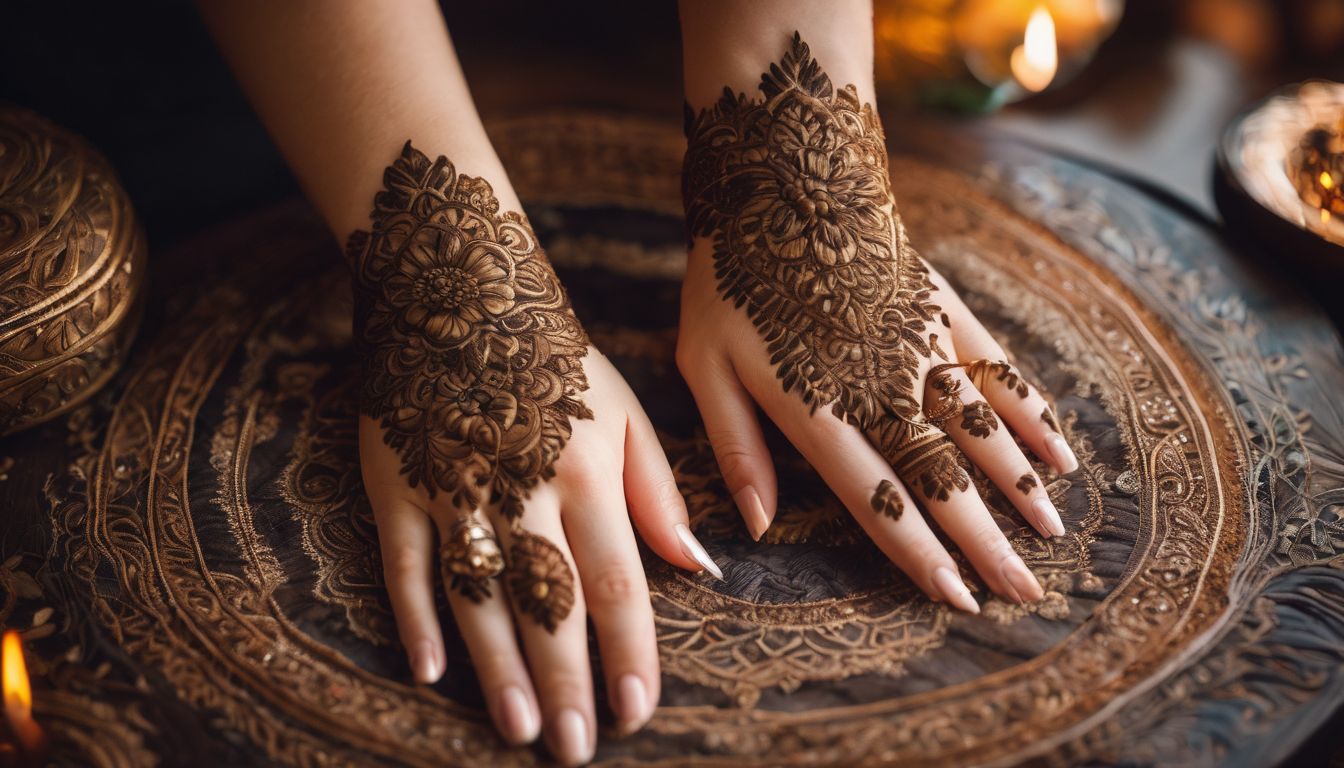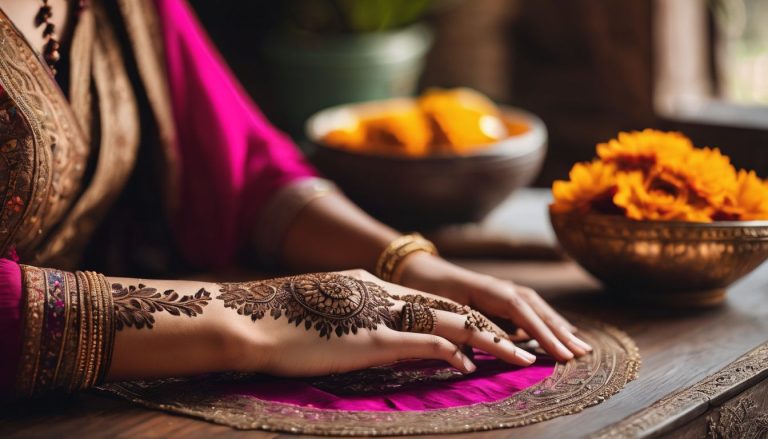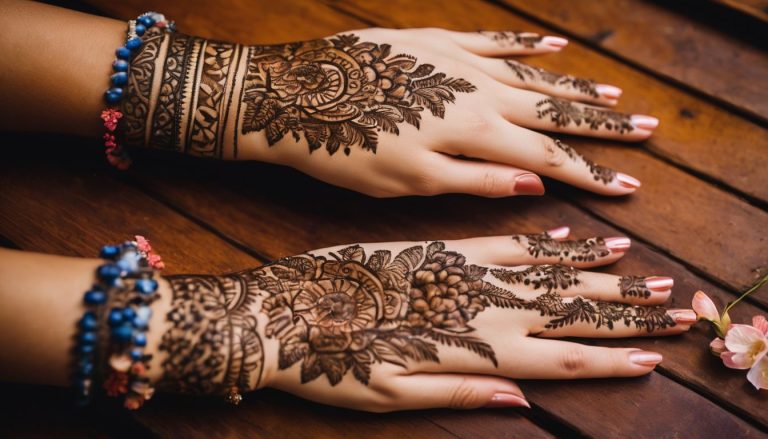The Ultimate Gallery of Henna Tattoo Designs: Inspiration for Your Next Body Art
Are you searching for a temporary splash of art on your skin? Henna tattoos have graced us with their beauty for centuries and stand out as a natural choice for non-permanent body designs.
This guide is packed with stunning henna tattoo patterns that will spark your creativity and show you how to wear these symbols with pride. Dive into the world of intricate lines and meaningful motifs that wait to adorn your skin!
Key Takeaways
- Henna tattoos, made from the leaves of the henna plant, have deep cultural significance in various regions and are often used to symbolize joy, beauty, and good fortune during significant occasions like weddings and festivals.
- Factors that affect the longevity of a henna tattoo include the quality of henna used, location on the body, duration of application, aftercare routine followed, and environmental factors such as humidity and temperature.
- Proper care for a henna tattoo includes letting it dry out and set for at least 6 hours after application; enhancing its color and longevity with a sugar water and lemon mixture; applying medical tape to protect it from cracking or smudging; washing gently with mild soap after removing the paste.
What is Henna and Its Cultural Significance
Moving from our initial overview, let’s delve into the essence of henna and its deep cultural roots. Henna is a natural dye made from the leaves of the henna plant, scientifically known as Lawsonia inermis.
For centuries, it has served not only as a source for creating stunning temporary tattoos but also as an integral part of cultural traditions across various regions, including India, Africa, and the Middle East.
These vibrant designs are often seen during significant occasions like weddings and festivals, where they represent joy, beauty, and good fortune.
The intricate patterns often found in henna tattoo designs carry specific meanings within their cultures. A common tradition sees brides adorned with elaborate henna patterns to symbolize love and prosperity in their marriage.
This art form goes beyond mere decoration; it acts as a language through which stories are told and blessings are invoked. As an emblematic form of body art that spans across gender lines today—though predominantly favored by women—henna continues to flourish globally both as a fashion statement and a testament to its lasting cultural imprint.
How Long Does a Henna Tattoo Last?
The longevity of a henna tattoo depends on various factors such as skin type, location of the design, and aftercare. Proper care and maintenance can help extend the life of your henna tattoo.
Factors that affect longevity
Factors that affect how long your henna tattoo lasts:
- The quality of the henna used, as higher quality henna tends to last longer and produce richer colors.
- The location of the tattoo on the body, as areas with thicker skin such as palms and soles tend to retain henna tattoos longer.
- The duration for which the henna paste is left on the skin, with longer application times resulting in a deeper stain and prolonged longevity.
- The aftercare routine followed, including avoiding water exposure for at least 24 hours after application to allow the dye to set properly.
- Environmental factors such as humidity and temperature can impact how quickly henna fades or darkens.
Tips for prolonging your tattoo
To keep your henna tattoo looking fresh for as long as possible, follow these tips:
- Keep it dry: Avoid contact with water for the first 24 hours to allow the henna to set properly.
- Seal it up: Apply a thin layer of lemon sugar mixture or medical tape over the design to protect it from moisture and perspiration.
- Avoid friction: Be gentle and mindful of the tattooed area to prevent premature fading.
- Moisturize: After the initial drying period, use natural oils like coconut or olive oil to moisturize the henna regularly.
- Protect from chemicals: Steer clear of lotions, soaps, and other products that may contain chemicals that can fade the henna prematurely.
Proper Care and Removal of Henna Tattoos
After getting a henna tattoo, it’s important to let it dry out and set for the best results. Proper care includes using sugar water and lemon to help the color last longer, as well as applying medical tape to protect the design.
Proper washing techniques are also crucial in maintaining your henna tattoo.
Letting it dry out and set
To ensure your henna tattoo lasts longer, you should let it dry out and set for at least 6 hours. During this time, avoid touching the design to prevent smudging or fading. This allows the henna to penetrate the top layer of your skin, resulting in a deeper and longer-lasting color.
Additionally, letting it dry out and set properly can also help enhance the intricate details of your henna tattoo.
After allowing the henna to dry completely, gently scrape off any dried paste without using water. This process helps reveal the rich brown stain left behind by the henna dye on your skin.
Using sugar water and lemon
After letting your henna tattoo dry and set, you can enhance its color and longevity by applying a mixture of sugar water and lemon. By doing so, you can intensify the pigment of the henna, resulting in a richer and darker stain on your skin.
The acidity from the lemon juice helps to lock in the dye while sugar acts as a natural adhesive that helps keep the henna paste intact. This method is commonly used to ensure that your henna design lasts longer and looks more vibrant.
Additionally, adding sugar water and lemon to your dried henna tattoo can help prevent it from cracking or flaking off prematurely. This simple yet effective technique has been tried and tested for generations, offering a natural way to extend the lifespan of your beautiful henna body art.
Applying medical tape
Once the henna tattoo has dried, applying medical tape over the design can help protect it from cracking or smudging. This gentle and adhesive tape provides a barrier against friction and moisture, helping to maintain the integrity of your henna tattoo for longer.
Additionally, using medical tape ensures that your design stays in place during everyday activities and prevents accidental rubbing or fading.
Proper care and attention to detail are crucial when preserving your henna art. The next step involves understanding proper washing techniques to further prolong the life of your beautiful design.
Proper washing techniques
To properly care for your henna tattoo, gently wash the area with mild soap and water after removing the paste. Pat the skin dry with a clean towel and avoid scrubbing to prevent premature fading of the design.
Follow up by applying a thin layer of natural oil or moisturizer to keep the skin hydrated and protect the henna from cracking. Remember to avoid excessive exposure to water, as it can cause the tattoo to fade more quickly.
After allowing your henna tattoo time to set, it is essential to practice proper washing techniques using mild soap and gentle patting motions when drying off. Additionally, apply a light moisturizer or natural oil after washing to keep your skin hydrated and protect your beautiful new body art from fading too soon.
Popular Placements for Henna Tattoos
Ideas for where to place your henna tattoo include hands and fingers, feet and ankles, wrists and forearms, and back and shoulders. Each placement offers a unique canvas for beautiful henna designs that can be showcased in different ways.
Hands and fingers
Henna tattoos on hands and fingers are a popular choice due to their visibility and intricate designs. These areas offer a canvas for beautiful patterns, from delicate floral motifs to detailed geometric designs.
Women often choose henna hand designs as an expression of creativity and tradition, while men can find bold and masculine styles that suit their personal aesthetic. Henna tattoo artists can create stunning hand and finger designs with meaningful symbolism, making them a unique form of self-expression.
When it comes to henna hand designs, the possibilities are endless, drawing inspiration from cultural traditions and personal preferences. From traditional Indian henna designs to modern minimalistic motifs, there’s a wide range of options available for those seeking creative body art expressions.
Feet and ankles
Transitioning from the intricate designs on hands and fingers to the lower extremities, henna tattoos on feet and ankles have gained popularity for their intricate and elegant look.
These areas provide a canvas for beautiful motifs such as floral patterns, vines, or geometric designs. Henna tattoos on feet are often chosen by individuals wanting a unique way to adorn themselves during special occasions like weddings, festivals, or simply as an expression of personal style.
The ankle is also favored for its visibility and flexibility in accommodating various design elements.
Wrist and forearm
Transitioning from popular placements for henna tattoos on the feet and ankles, the wrist and forearm are also prime locations to showcase intricate designs. Henna art on the wrist is a timeless choice, blending seamlessly with bracelets or bangles.
The forearm offers a larger canvas for more elaborate patterns and motifs. Many people opt for symbolic designs that hold personal meanings when adorning their wrists or forearms with henna tattoos.
The wrist and forearm serve as prominent sites for henna tattoo application due to their visibility and versatility in displaying elegant designs. These areas provide an excellent opportunity to express individuality through henna art, making it a popular choice among those seeking unique body adornments.
Back and shoulders
Transitioning from popular placements on the wrist and forearm, henna tattoo designs are also commonly adorned onto the back and shoulders. These areas offer a larger canvas for intricate patterns, creating stunning and eye-catching body art.
The back and shoulders are ideal locations for showcasing elaborate henna designs that draw attention with their detailed beauty. Henna tattoo artists often utilize the space to craft unique and personalized designs that accentuate the natural contours of the body while making a bold statement.
Embracing henna artistry on your back or shoulders allows for versatile expressions of creativity, including traditional motifs, contemporary patterns, or personalized symbols that hold special meaning.
Inspirational Henna Tattoo Designs and Their Meanings
Explore the symbolism and significance behind popular henna tattoo designs such as twisted henna, floral motifs, sun and moon patterns, traditional Indian and Moroccan designs, as well as modern and minimalistic styles.
Discover the rich cultural meanings behind these intricate body art designs that will inspire your next henna tattoo creation!
Twisted henna
Twisted henna designs are known for their intricate and elaborate patterns, featuring a unique blend of geometric shapes and twisting lines. These designs often symbolize strength, resilience, and the interconnectedness of life.
The intertwining lines in twisted henna patterns can represent the complexities of human emotions and experiences, making them a popular choice for those seeking body art with deep meaning.
Artists skillfully create these captivating designs using precise techniques to ensure stunning results.
The use of twisted henna as temporary body art allows individuals to express their inner strength through the beauty of intricate patterns on their skin. This form of henna design is versatile, appealing to both men and women who appreciate artistry that reflects vitality and complexity.
Feminine floral designs
Transitioning from the intricate patterns of twisted henna, feminine floral designs offer a delicate and graceful option for henna tattoos. With their soft curves and elegant petals, floral motifs symbolize beauty, love, and nature.
Popular choices include roses, lotus flowers, and jasmine vines. These designs are often used to celebrate important events such as weddings or festivals due to their association with femininity and joy.
Additionally, these motifs can be combined with other elements like leaves or vines to create unique and personalized designs that reflect the wearer’s personality.
Floral henna motifs have been cherished for centuries in various cultures for their timeless elegance and symbolic meanings. Embracing feminine energy and natural beauty through these designs adds a touch of grace and sophistication to any henna tattoo.
Sun and moon motifs
Henna tattoo designs often feature sun and moon motifs, symbolizing opposing forces like light and dark, day and night. The sun can represent strength, energy, and power, while the moon is associated with femininity, intuition, and transformation.
These celestial symbols add depth to henna tattoos by infusing them with meanings of balance and duality. Their intricate patterns create visually striking body art that captures attention with its symbolic richness.
Intricate henna designs featuring sun and moon motifs are popular choices for those seeking meaningful body art that reflects cosmic energies. With their versatile symbolism, these motifs allow for personal expression through unique combinations of elements such as stars or floral patterns.
Traditional Indian and Moroccan designs
Transitioning from the celestial allure of sun and moon motifs, we delve into the rich and intricate world of traditional Indian and Moroccan henna designs. Inspired by centuries-old cultural traditions, these designs boast a tapestry of mesmerizing patterns and symbols that hold deep significance in both Indian and Moroccan heritage.
In Indian henna art, paisley, peacock feathers, lotus flowers, and mango leaves are popular elements symbolizing fertility, good luck, love, prosperity, abundance or awakening. Meanwhile, Moroccan henna art is characterized by geometric shapes such as triangles or diamonds alongside floral patterns to reflect beauty in nature.
Both styles are celebrated for their detailed elegance.
Modern and minimalistic designs
Transitioning from the traditional intricacy of Indian and Moroccan designs, modern henna tattoos have embraced a more minimalist outlook. These contemporary designs often feature sleek lines and geometric patterns that exude elegance and simplicity.
Additionally, some minimalistic henna tattoos incorporate negative space to create stunning visual effects, making them quite popular among those seeking a refined yet striking body art style.
Modern henna designs are also influenced by current trends in the fashion and beauty industry, with elements such as fine linework, subtle dotting, and abstract shapes being incorporated into these understated yet impactful creations.
Conclusion
In conclusion, henna tattoos offer a rich and diverse form of body art with deep cultural significance. The wide array of designs and meanings allow for personal expression and creativity.
Whether you opt for traditional motifs or modern minimalistic styles, henna tattoos are a beautiful way to adorn your body temporarily. Embracing this ancient art form can bring an infusion of history and culture into your contemporary life.
Explore the world of henna tattoo designs to find inspiration for your next unique and meaningful body art.
FAQs
1. What can The Ultimate Gallery of Henna Tattoo Designs show me?
The Ultimate Gallery offers loads of henna tattoo inspiration, showcasing intricate tattoos, traditional designs, and the latest trends in henna art.
2. Why should I consider a henna tattoo’s meaning before choosing one?
Understanding the symbolism behind different patterns can help you pick a design that matches your personality or celebrates your culture, like Moroccan patterns or floral motifs.
3. How much does a henna tattoo typically cost?
Henna tattoo pricing varies based on size and intricacy but expect to spend anywhere from pocket money for simple designs to more for detailed artwork.
4. Are there different techniques used in creating henna tattoos?
Yes! Artists apply various methods, including traditional Mehndi patterns and modern geometric designs, giving each piece a unique look and style.
5. Can learning about henna tattoo history add to my body art experience?
Absolutely! Knowing about the traditions and culture of henna adds depth to your choice and connects you with centuries-old practices in body art.



